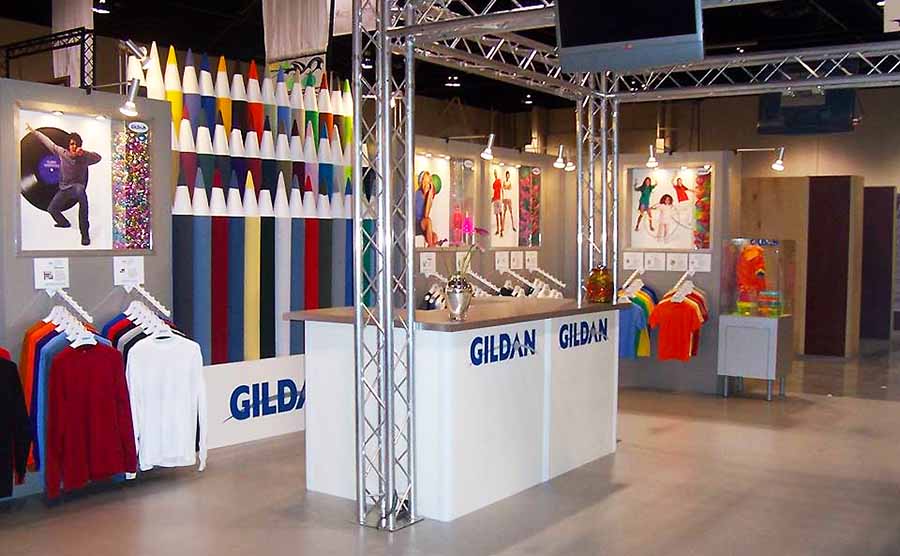Gildan Activewear reported earnings on an adjusted basis were down 6.2 percent in the fourth quarter. Sales fell 11.3 percent as activewear sales were hurt by lower imprintables volumes in North America.
Gildan said in its statement, “Overall for 2019, we were pleased with the progress we made on our “Back to Basics” strategy intended to simplify our product portfolio and reduce complexity in manufacturing and distribution as we continue to enhance our competitive positioning. Net sales and adjusted diluted EPS in the fourth quarter unfolded largely in line with our expectations when we reported our third-quarter results before recognizing the impact of a sales return allowance.”
Fourth Quarter Results
Net sales for the fourth quarter ended December 29, 2019, of $658.7 million were down 11.3 percent compared to the fourth quarter of 2018 due primarily to a 15.1 percent decline in activewear sales, slightly offset by a 1.0 percent sales increase in the hosiery and underwear category. The decline in overall net sales in the quarter was mainly the result of lower unit sales volumes and the negative impact of the $19 million sales return allowance recorded in the fourth quarter. Before accounting for the sales return allowance, total net sales in the fourth quarter were essentially in line with its expectations as the positive benefit on sales from lower than anticipated levels of U.S. distributor inventory. De-stocking of imprintables was offset by the negative impact of weaker than expected market demand in retail, particularly in hosiery.
In activewear, Gildan generated sales of $483.5 million in the fourth quarter, down $85.8 million compared to the fourth quarter last year, due primarily to lower unit sales volumes stemming from the combined impact of lower POS from distributors to screen printers and distributor inventory de-stocking, as well as the impact of the sales return allowance. The sales volume decline was mainly due to lower imprintables volumes in North America, partly offset by higher activewear sales in retail and modest growth in international shipments of imprintable activewear. Sales in the hosiery and underwear category for the quarter totaled $175.1 million, up $1.7 million over the fourth quarter in 2018, as strong double-digit sales volume growth of underwear, which also drove more favorable product-mix, was largely offset by lower sock sales. While industry demand for men’s underwear was down in the quarter, as reported by NPD Retail Tracking service, its underwear sales were very strong. The large increase in underwear sales was mainly due to its new private label men’s underwear program with its largest mass retail customer, which rolled out earlier this year, and gained additional shelf space during the fourth quarter as the program offering was expanded. The decline in sock sales during the quarter reflected overall weaker industry demand and stemmed mainly from declines in mass and other channels, including the exit of a sock program in the dollar channel. E-commerce sales were strong in the quarter, up more than 50 percent.
Reported gross margin in the fourth quarter was 17.9 percent compared to the gross margin of 26.3 percent in the fourth quarter last year. Excluding the $55 million charge related to its Back to Basics strategy, adjusted gross margin was 25.6 percent compared to 26.3 percent for the same quarter last year, down 70 basis points. The decline was largely due to higher royalty expenses in the quarter related to licensed brand sock sales, which impacted the adjusted gross margin by approximately 50 basis points, as well as higher manufacturing input costs. The negative impact of these factors more than offset the benefit of cost savings from the company’s manufacturing optimization initiatives and favorable product-mix from higher-margin underwear sales.
SG&A expenses for the fourth quarter of 2019 of $76.5 million were down 16.8 percent compared to $91.9 million in the fourth quarter of 2018. As a percentage of sales, SG&A expenses were 11.6 percent, down 80 basis points from 12.4 percent in the fourth quarter last year. The improvement was mainly attributable to lower compensation expenses and cost benefits from the company’s ongoing focus on SG&A rationalization.
Operating income for the fourth quarter of 2019 totaled $24.3 million, or 3.7 percent of sales, down from $78.2 million, or 10.5 percent of sales in the fourth quarter of 2018. After excluding restructuring and acquisition-related costs and the $55.0 million charge in connection with its Back to Basics strategy, adjusted operating income for the quarter amounted to $95.3 million, down from $99.9 million in the fourth quarter last year. Adjusted operating income was 14.1 percent of sales compared to the adjusted operating margin of 13.5 percent last year. The 60 basis-point improvement was mainly driven by the decline in SG&A expenses, partly offset by lower adjusted gross margin.
Gildan incurred $16.0 million of restructuring and acquisition-related costs in the fourth quarter and $47.3 million for the full-year of 2019. These costs primarily related to previously announced manufacturing optimization initiatives in connection with the consolidation of textile, hosiery, sewing, and yarn operations, including estimated costs related to the decision Gildan made at the end of October to relocate its Mexican operations to Central America and the Caribbean Basin, as well as other consolidation initiatives related to sales and marketing activities.
Gildan reported an income tax recovery for the quarter of $17.8 million compared to an income tax expense of $10.0 million in the fourth quarter of 2018. The 2019 income tax recovery included a deferred income tax recovery of $19.2 million related to the recognition of previously de-recognized deferred income tax assets, compared to related deferred income tax expenses of $7.1 million included in the income tax expense for the fourth quarter of 2018. Excluding the full-year impact of restructuring and acquisition-related costs and deferred income tax adjustments in both years, as well as the 2019 charge related to its Back to Basics strategy, the effective income tax rate for 2019 was 3.5 percent, slightly lower than the anticipated full-year tax rate of 4 percent.
Net earnings totaled $32.5 million, or $0.16 per share, on a diluted basis for the three months ended December 29, 2019, compared to net earnings of $59.6 million, or $0.29 per share on a diluted basis, for the three months ended December 30, 2018. The decline in net earnings and diluted EPS was mainly due to lower sales and a lower operating margin, including the impact of the charge related to its Back to Basics strategy, partly offset by lower income taxes. Adjusted net earnings totaled $83.4 million, or $0.41 per diluted share in the quarter, down from adjusted net earnings of $88.9 million, or $0.43 per diluted share in the fourth quarter last year. The 4.7 percent decline in adjusted diluted EPS was mainly due to lower sales in the quarter and the decrease in adjusted gross margin, partly offset by lower SG&A expenses.
Full-Year Results
Net sales for 2019 totaled $2,823.9 million, down 2.9 percent over last year, reflecting activewear sales of $2,261.9 million, down 2.6 percent over last year, and sales in the hosiery and underwear category of $562.0 million, down 4.3 percent compared to 2018. Overall sales were in line with its most recent full-year guidance calling for a decrease in total net sales in the low-single-digit range. The decrease in activewear sales for the year was mainly due to lower unit sales volume in the imprintables channel both in North America and internationally, partly offset by higher sales of activewear in the retail channel, including private brands and strong sales in the craft channel, as well as a favorable product mix and higher net selling prices. Sales in the hosiery and underwear category were down $25.2 million over the prior year, as strong double-digit underwear sales growth driven by its new private brand men’s underwear program in mass, which also contributed to a favorable product-mix, was more than offset by lower unit sales of socks, including the impact of the exit of a sock program in the dollar channel.
Net earnings for 2019 were $259.8 million, down from net earnings of $350.8 million in 2018. GAAP diluted EPS totaled $1.27, down 23.5 percent from $1.66 in the prior year. The decline in net earnings and diluted EPS for 2019 was due to the lower operating income and higher financial expenses, partly offset by lower income taxes resulting from tax recoveries related to the recognition of previously de-recognized deferred income tax assets. Adjusted net earnings for 2019 were $339.6 million, or $1.66 per diluted share, within the company’s adjusted EPS guidance range of $1.65 to $1.70, and down 13.6 percent and 10.8 percent, respectively, compared to adjusted net earnings of $393.1 million or $1.86 per diluted share in 2018. The decrease in adjusted net earnings and adjusted diluted EPS for 2019 over the prior year was primarily due to the decrease in adjusted operating income and higher financial expenses, partially offset by the benefit of a lower year-over-year share count. Adjusted EBITDA for the year totaled $548.1 million and was in line with the company’s guidance range of $545 to $555 million.
Outlook
For 2020, the company is projecting GAAP EPS on a diluted basis in the range of $1.70 to $1.80 and adjusted diluted EPS in the range of $1.85 to $1.95, on projected sales growth for the year of 2 percent to 4 percent. GAAP EPS includes projected restructuring and acquisition-related costs of up to $30 million, primarily relating to previously announced manufacturing and distribution optimization initiatives as part of the company’s Back to Basics strategy aimed at simplifying its business and driving operational efficiencies throughout the organization. Adjusted EBITDA for 2020 is expected to be in the range of $580 million to $600 million. The company expects to generate free cash flow for 2020 in the range of $325 million to $375 million after projected capital expenditures of approximately $125 million primarily for investments in manufacturing capacity expansion. The company’s guidance is based on the assumption of a stable global macroeconomic environment. In addition, at this time, the company does not project, and has not incorporated in its guidance, any meaningful impact on its business resulting from the current outbreak of the coronavirus in China. The company will continue to monitor the situation as it evolves.
Gildan is a leading manufacturer of everyday basic apparel under a diversified portfolio of company-owned brands including Gildan, American Apparel, Comfort Colors, Gildan Hammer, Prim + Preux, GoldToe, Anvil by Gildan, Alstyle, Secret, Silks, Kushyfoot, Secret Silky, Therapy Plus, Peds and MediPeds, and under the Under Armour brand through a sock licensing agreement providing exclusive distribution rights in the U.S. and Canada.
Photo courtesy Gildan Activewear















